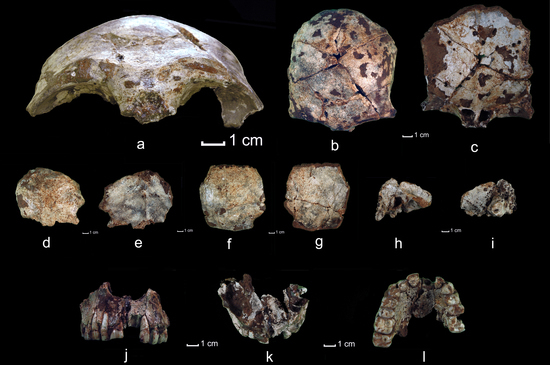The Oldest Human Fossils in Southeast Asia?
Researchers claim skull fragments and teeth discovered in a cave in Laos may be the oldest modern human fossils ever found in mainland Southeast Asia
![]()

Dating to 46,000 to 63,000 years ago, the human fossils found in Tam Pa Ling, Laos, are among the earliest Homo sapiens bones ever found in Southeast Asia. Image: F. Demeter
In 2009, paleoanthropologists working in a cave in Laos unearthed skull bones and teeth belonging to a modern human. Dating to between 46,000 and 63,000 years ago, the bones may be the earliest fossil evidence of Homo sapiens in mainland Southeast Asia, researchers reported last week in Proceedings of the National Academy of Sciences.
The fossils—a partial skull, jaw fragments and teeth—were found in Tam Pa Ling (Cave of the Monkeys). Several physical features indicate the individual was human, including a lack of browridges, a widening of the skull behind the eyes and smaller teeth relative to earlier hominids. The third molar was just surfacing, suggesting the individual was a young adult.
No artifacts were found with the bones, which appear to have washed into the cave. Radiocarbon and luminescence dating (a measure of the last time something was heated or exposed to sunlight) of charcoal and sediments directly above and below the fossils indicate the bones were deposited in the cave 46,000 to 51,000 years ago, making that a minimum age of the bones. Dating a piece of the skull with uranium dating shows the the fossils are no older than 63,000 years. (The University of Illinois has several pictures of the fossils and cave site.)
The discovery is important because scientists haven’t found too many human fossils in eastern Asia dating to between 120,000 and 40,000 years ago, even though genetic evidence and stone tools suggest people must have been in the area. “There are other modern human fossils in China or in Island Southeast Asia that may be around the same age, but they either are not well dated or they do not show definitively modern human features,” team leader Laura Shackelford of the University of Illinois at Urbana-Champaign said in a press release. “This skull is very well dated and shows very conclusive modern human features.”
Other early modern human fossils in East Asia include skull fragments found in 1976 at the Xujiayao site in northeastern China. Based on the age of rhinoceros teeth found in the same location, the bones have been dated to 104,000 to 125,000 years ago, but some researchers have questioned whether the human fossils were really found in the same geologic layer as the rhino remains. There’s also a partial lower jaw from Zhirendong in southern China that’s been clearly dated to about 100,000 years ago, but some experts question whether it’s really from a modern human. In 2010, I reported on the discovery of a 67,000-year-old toe bone found in the Philippines. The fossil belongs to the genus Homo, but a single foot bone is not enough to determine the exact species.
Finding the physical remains of modern humans is important in clarifying the history of human migration into this part of the world, especially now that we know other hominids lived in eastern Asia at the end of the Pleistocene. The tiny Hobbit lived in Flores as recently as 17,000 years ago. And last year scientists learned that the Denisovans, a hominid species known only from DNA recovered from a finger bone and tooth, must have lived in Asia at the same time as modern humans: Genetic evidence from modern Southeast Asians, Australian Aborigines, Melanesians and other people of Oceania suggests humans and Denisovans interbred.
But it’s hard to find hominid fossils in Southeast Asia. The warm, wet environment inhibits fossil preservation, which probably explains why so many fossils in the area have been found in cooler, drier caves. Let’s hope this latest discovery spurs other anthropologists to start searching for more fossils to fill in the East Asian gap in early modern human history.
/https://tf-cmsv2-smithsonianmag-media.s3.amazonaws.com/accounts/headshot/science-erin-wyman-240.jpg)
/https://tf-cmsv2-smithsonianmag-media.s3.amazonaws.com/accounts/headshot/science-erin-wyman-240.jpg)